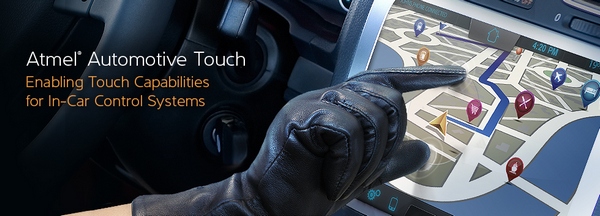New Automotive-Qualified maXTouch Devices Support Shieldless Sensor Designs, Reduce System Complexity, and Enable Multi-Touch Gestures Including Gloved Finger Operation
Atmel Corporation announced the availability of its maXTouch family for 5" to 10" automotive touchscreens and touchpads used in center stack displays, navigation systems, radio human-machine interfaces (HMIs) and rear-seat entertainment systems. With these new automotive-qualified maXTouch devices, Atmel strengthens its position as a market-leading touch supplier and extends its range of supported maXTouch applications from consumer and industrial into automotive.

The new automotive-qualified devices include the maXTouch mXT768E and the maXTouch mXT540E, which are part of a family known for its superior performance and rich feature set. This family offers unlimited touch identification, fast response time, exacting precision, robust operation and low power consumption.
Dedicated Embedded Functionality for Automotive
The mXT768E and mXT540E devices are fully automotive-qualified (Grade 2, AEC-Q100-compliant), supporting a temperature range of -40 up to +105 degree Celsius. In addition, they provide dedicated embedded functionality that meets automotive design requirements.
Support for shieldless sensors is an important requirement for automotive designs. With maXTouch automotive-qualified devices, designers can use single-layer sensors instead of dual or even triple layers, as is currently applied in many applications. Conventional touch controllers are unable to handle LCD noise, so a shield is required to prevent noise coupling. Automotive-qualified maXTouch devices provide superior noise immunity, eliminating the need for shields. This, in turn, enables single-layer sensor designs for thinner stacks, which reduces system complexity, lowers overall cost and power consumption, and results in higher product yield during automotive systems production. The high signal-to-noise ratio of 80:1 in automotive-qualified maXTouch devices makes them ideally suited for very noisy environments. Since only a high signal-to-noise ratio enables detection of touches with a "gloved" finger, the devices provide full support for gloved hand operation on automotive touchscreens.
The mXT768E/ mXT540E devices also embed single- and dual-touch gesture calculation as well as post-processing algorithms which eliminate unintended touches. Users can perform multi-touch gestures (pinch, stretch, etc.), while unintended touches such as a resting hand on the screen are classified and rejected. These functionalities bring the smartphone experience into contemporary cars.
"Emerging automotive applications as well as the trend from resistive to capacitive touch technology require easy-to-use solutions that can be quickly integrated," said Stephan Thaler, Atmel marketing director for Automotive Touch Products. "With the mXT768E and mXT540E devices, a totally integrated center stack including touchscreens, multiple buttons and/or sliders (replacing mechanical buttons) can be realized with just one single controller, thus reducing development time, system complexity and cost. And end users will enjoy the familiar smartphone experience in their car."
"As touchscreens become more pervasive, this technology clearly presents an attractive feature for auto manufacturers to integrate into their vehicles," said Susie Inouye, research director, Databeans, Inc. "In fact, the semiconductor market for automotive applications is growing at a compound annual growth rate of 8 percent and is expected to reach $36.4 billion by 2016. Atmel, with its automotive-qualified maXTouch devices, is strongly positioned to capitalize on this market growth while helping automotive application designers create in-car touchscreens that will delight their customers."
Additional maXTouch capabilities targeting automotive applications include frequency hopping during burst generation, self calibration, detect integration addressing EMI/EMC requirements and high reliability in harsh environments. With a scan speed of up to 150Hz, design engineers can provide character recognition for alphanumeric inputs to the automotive HMI interfaces, another key feature for modern cars.
Availability
Samples of automotive-qualified mXT768E and mXT540E touch controllers are available now in TQFP100 packages. Demo kits for both devices are also available to support design-in and shorten time to market.
